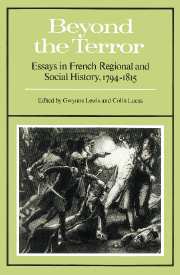Book contents
- Frontmatter
- Contents
- Contributors
- Preface
- 1 Cobb and the historians
- 2 The reconstruction of a church 1796–1801
- 3 Picking up the pieces: the politics and the personnel of social welfare from the Convention to the Consulate
- 4 Conscription and crime in rural France during the Directory and Consulate
- 5 Common rights and agrarian individualism in the southern Massif Central 1750–1880
- 6 Themes in southern violence after 9 thermidor
- 7 Political brigandage and popular disaffection in the south-east of France 1795–1804
- 8 Rhine and Loire: Napoleonic elites and social order
- Index
2 - The reconstruction of a church 1796–1801
Published online by Cambridge University Press: 04 November 2009
- Frontmatter
- Contents
- Contributors
- Preface
- 1 Cobb and the historians
- 2 The reconstruction of a church 1796–1801
- 3 Picking up the pieces: the politics and the personnel of social welfare from the Convention to the Consulate
- 4 Conscription and crime in rural France during the Directory and Consulate
- 5 Common rights and agrarian individualism in the southern Massif Central 1750–1880
- 6 Themes in southern violence after 9 thermidor
- 7 Political brigandage and popular disaffection in the south-east of France 1795–1804
- 8 Rhine and Loire: Napoleonic elites and social order
- Index
Summary
‘deux sortes de queues: queues à la messe, queues à la porte des boulangeries’.
(Paris, Lent, 1795)‘La Révolution aux yeux du peuple catholique est promotion bourgeoise et protestante.’
(A. J. Tudesq)‘Laissez une paroisse vingt ans sans prêtre, on y adorera les bêtes.’
(Curé d'Ars)In the history of catholicism in France the years 1789–1801 constitute a watershed. It was not merely that the church lost its landed wealth or its claim to a monopoly of truth, that 50 per cent or more of those responsible for the cure of souls in 1789 found themselves in flight or that images were broken and acts of orgiastic desecration were perpetrated. It was that the total experience had a profound and lasting effect upon the laity. Neither catholics nor the institution to which they lent adherence were ever quite the same again. The revolutionary decade emphatically severs a world of almost unquestioned obeissance to catholic teaching from one in which significant sectors of the populace slipped away into indifference.
The eighteenth-century church was very much the product of the post-Tridentine reform movement. Its most outstanding characteristic was a seminary-trained priesthood whose education, periodically reinforced by conference and retreat, committed the parochial clergy to define their chief function as the elevation of the spiritual level of their flock by unproved catechetical instruction, a remorseless attack on lax morality and on the ‘superstitious’ aspects of popular religion, such as local cults of pagan or doubtful derivation, or customs, such as the ringing of the parish bell to avert hail.
- Type
- Chapter
- Information
- Beyond the TerrorEssays in French Regional and Social History 1794-1815, pp. 21 - 52Publisher: Cambridge University PressPrint publication year: 1983
- 4
- Cited by

